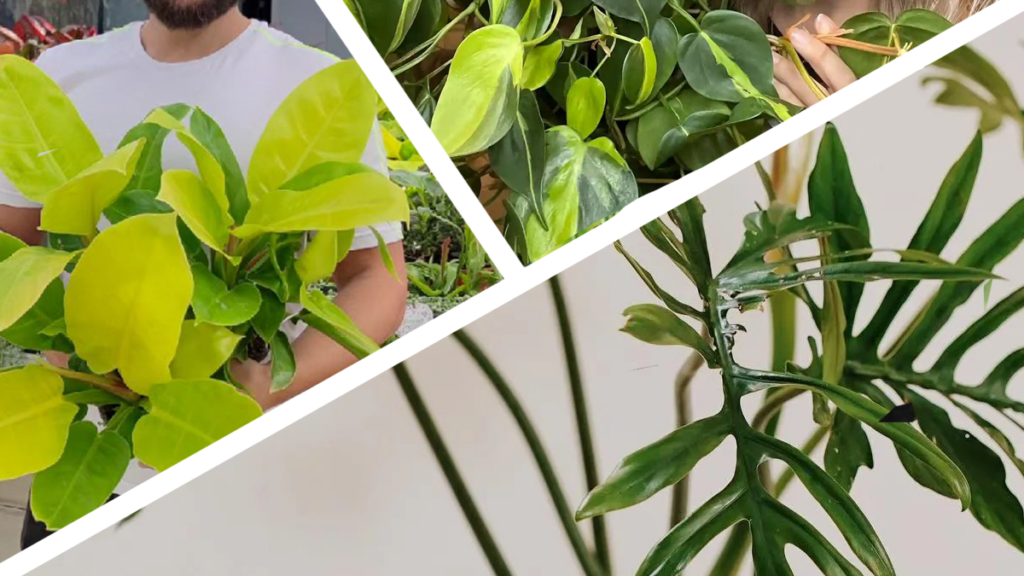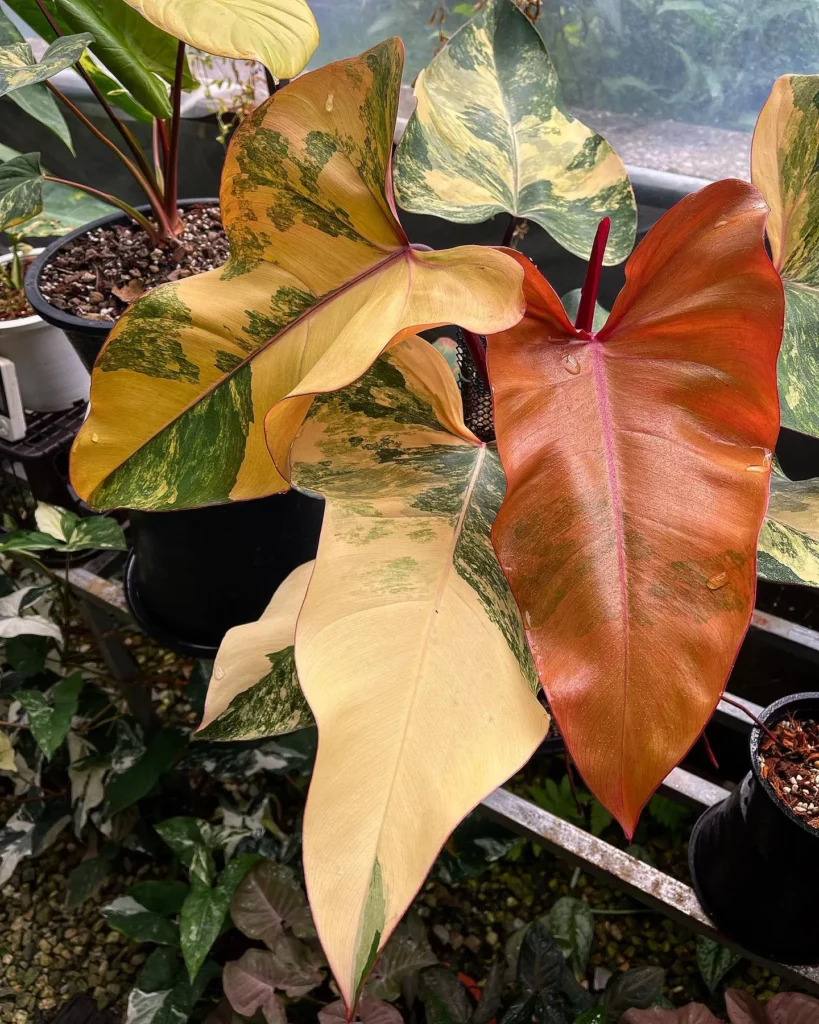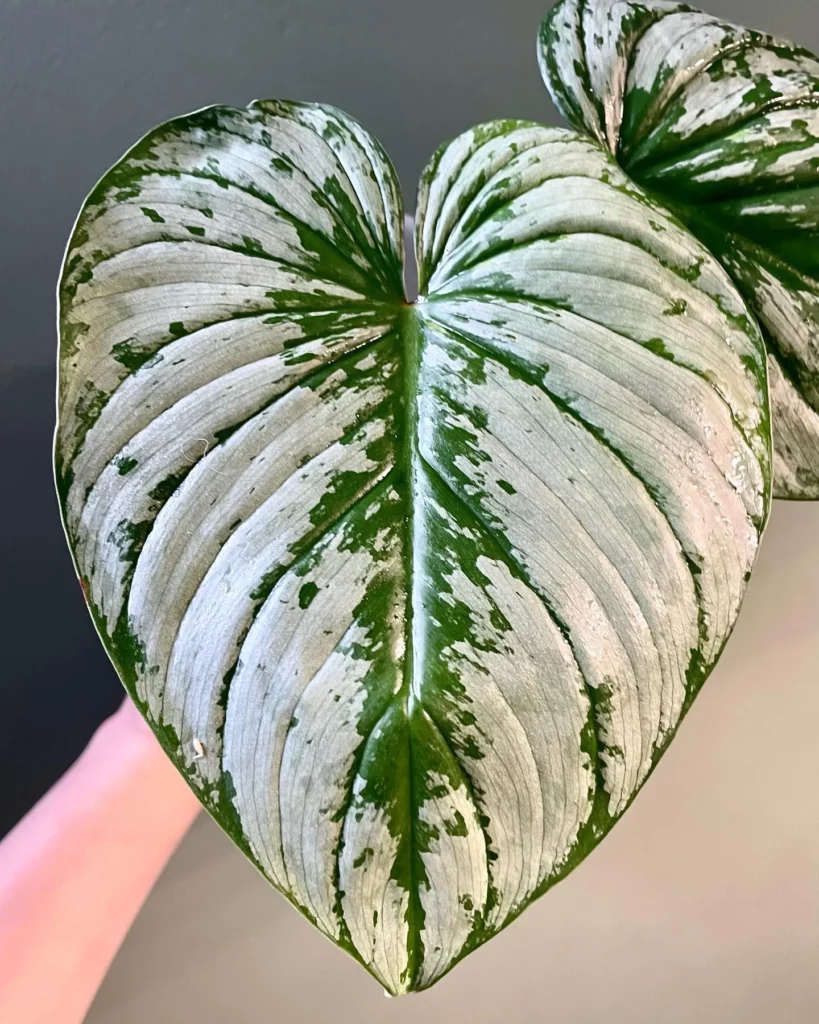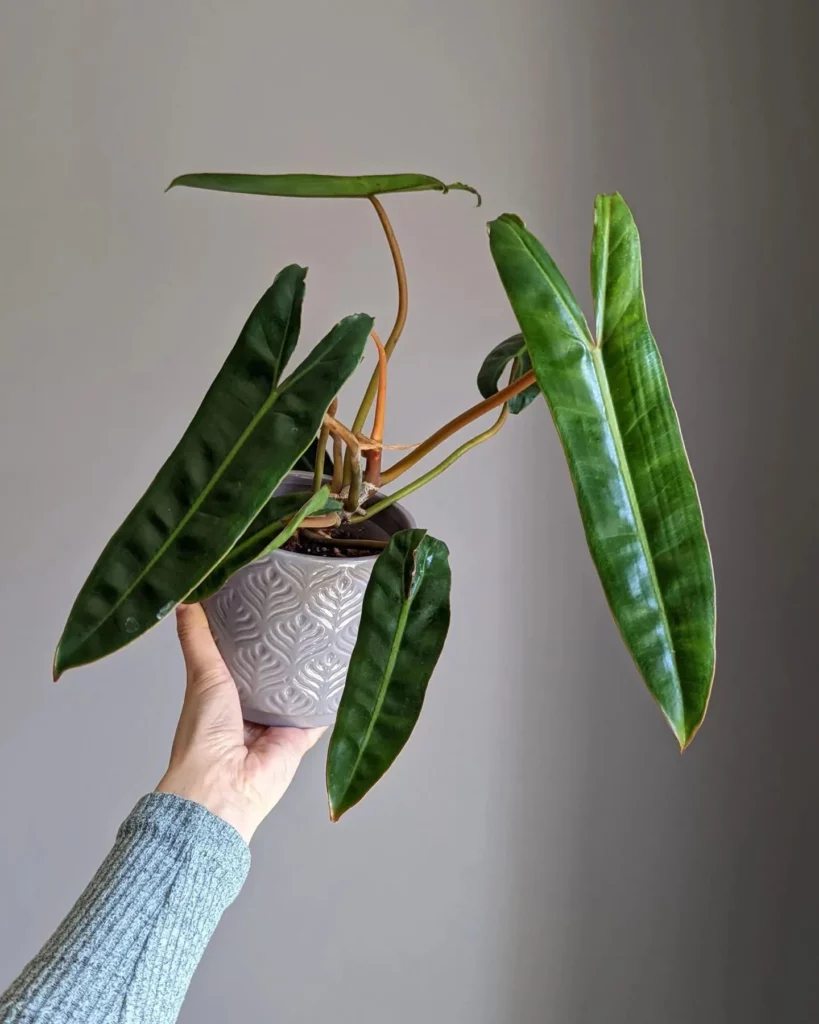The Philodendron erubescens ‘Strawberry Shake’, is a must-have for any indoor gardening enthusiast. If you’re looking to add a touch of vibrant color to your home, this tropical beauty is the perfect choice. Not only does it boast eye-catching pink, yellow, and cream-colored leaves, but it also brings joy and a sense of natural beauty to any space.
Appearance of the Strawberry Shake Philodendron



The Strawberry Shake Philodendron, also known as Philodendron erubescens ‘Strawberry Shake,’ is an eye-catching houseplant with stunning variegated leaves. Its large leaves are deeply lobed and can grow up to 12 inches long on trailing stems. What makes this plant truly unique is its coloration. The leaves are beautifully variegated with shades of pink, yellow, and cream, creating a vibrant and tropical look.
When new leaves emerge, they have a gorgeous pinkish-red color with bright red stems, which gradually fade to an attractive olive-green as they mature. The combination of these vibrant colors and the plant’s lush foliage makes the Strawberry Shake Philodendron a true showstopper in any home or indoor garden.
Gorgeous Variegation
- The leaves of the Strawberry Shake Philodendron are variegated with pink, yellow, and cream colors.
- New leaves have a unique pinkish-red color with bright red stems.
- Color gradually fades to an attractive olive-green as leaves mature.
Large and Lush Foliage
- The leaves of this philodendron are deeply lobed and can grow up to 12 inches long.
- The plant has a trailing growth habit, adding an elegant touch to any space.
- Its lush foliage creates a lush and tropical atmosphere in your home.
Light Requirements for the Strawberry Shake Philodendron



The strawberry shake philodendron, with its stunning variegated leaves, requires specific light conditions to thrive in your home. Here are some essential tips on providing the right amount of light for your strawberry shake philodendron:
- Indirect light is key: Place your strawberry shake philodendron near a sunny window where it can receive bright, indirect light. Direct sunlight can scorch the delicate leaves, so it’s crucial to avoid placing the plant in direct sunlight.
- Find the perfect spot: Look for a location in your home that offers bright, indirect light throughout the day. East or west-facing windows are usually ideal for providing the right amount of light without exposing the plant to intense sun rays.
- Adjust as needed: Observe how your plant responds to the available light. If the leaves start to lose their variegation or if the plant develops elongated, leggy growth, it may be an indication that it needs more light. Conversely, if the leaves become pale or develop brown spots, it may be getting too much direct sunlight.
Watering the Strawberry Shake Philodendron



Proper watering is essential for the health and vitality of the Strawberry Shake Philodendron. As a tropical plant, it thrives in consistently moist soil, but overwatering can lead to root rot. To strike the right balance, here are some watering tips:
1. Assess soil moisture
Before watering, check the moisture level of the soil by inserting your finger about an inch deep. If the soil feels dry, it’s time to water. If it still feels slightly moist, wait a day or two before watering again.
2. Water thoroughly
When it’s time to water, make sure to thoroughly saturate the soil. Water until you see it draining out of the pot’s drainage holes. This helps ensure that the entire root system receives moisture.
3. Allow proper drainage
After watering, allow any excess water to drain out completely. Empty the saucer beneath the pot to prevent the plant from sitting in standing water, which can lead to root rot.
4. Watch for signs of watering issues
Monitor your Strawberry Shake Philodendron for any signs of underwatering or overwatering. Yellowing leaves may indicate underwatering, while wilting or blackened leaves may indicate overwatering. Adjust your watering frequency accordingly.
Fertilizing the Strawberry Shake Philodendron



Proper fertilization is essential for the optimal growth and health of your beautiful strawberry shake philodendron. Here are some expert tips on how to fertilize this stunning houseplant:
1. Choose the Right Fertilizer
When fertilizing your strawberry shake philodendron, it is important to choose a balanced liquid fertilizer. Look for a fertilizer specifically formulated for houseplants or foliage plants. Avoid using fertilizers high in nitrogen, as this can lead to excessive leaf growth at the expense of variegation.
2. Dilute the Fertilizer
To avoid over-fertilizing and potentially damaging your plant, dilute the fertilizer to half strength. This will provide the necessary nutrients without overwhelming the roots. Follow the instructions on the fertilizer package for proper dilution ratios.
3. Fertilize During the Growing Season
The strawberry shake philodendron is a medium to light feeder and only requires fertilization once a month during the growing season, which typically includes spring and summer. As temperatures begin to drop in early fall, it is best to stop fertilization to allow the plant to enter its dormant period.
No products found.
Potting the Strawberry Shake Philodendron


When it comes to potting the Strawberry Shake Philodendron, it’s important to choose the right type of soil mix and container for optimal growth. Here are some essential tips to help you pot your plant successfully:
1. Soil:
The Strawberry Shake Philodendron thrives in a well-draining soil mix that retains some moisture. You can use a specially formulated aroid soil mix or create your own by combining indoor potting soil, perlite, and orchid bark. This mix provides the right balance of moisture retention and aeration, preventing the roots from becoming waterlogged.
2. Container:
Choose a container that has drainage holes to allow excess water to escape. Avoid using a container that is too large for your plant, as this can lead to overwatering and root rot. The size of the container should be proportionate to the size of the plant, providing enough room for the roots to grow and expand.
3. Repotting:
The Strawberry Shake Philodendron should be repotted every one to two years or when it has outgrown its current container. To repot, gently remove the plant from its old container and shake off any excess soil from the roots. Place the plant in the new container, making sure it sits at the same depth as before. Fill the remaining space with fresh soil mix, pressing it lightly around the roots to secure the plant.
Propagating the Strawberry Shake Philodendron
If you want to expand your collection of strawberry shake philodendrons or share this stunning plant with friends, propagating is a great option. There are a few different methods you can use to propagate the strawberry shake philodendron, each with its own advantages. Let’s explore these propagation techniques below.
1. Stem Cuttings
One of the most common ways to propagate the strawberry shake philodendron is through stem cuttings. To do this, select a healthy stem with at least three to five nodes and one leaf. Use a clean, sharp knife or shears to make a clean cut just below a node. Remove any lower leaves from the cutting, leaving one or two pairs of leaves at the top.
Next, you can choose between rooting the cutting in water or a moist potting mix. If using water, place the cutting in a glass or jar filled with water, ensuring that at least one node is submerged. Change the water every few days to prevent bacterial growth. If using a potting mix, prepare a well-draining mix of peat moss and perlite or vermiculite. Plant the cutting in the mix, burying one or two nodes below the surface.
Regardless of the method you choose, place the cutting in a warm, humid environment with indirect light. Mist the cutting regularly to maintain humidity and prevent drying out. After a few weeks, roots should start to develop. Once the roots are at least an inch long, you can transplant the cutting into a small pot with well-draining soil.
2. Air Layering
Another method to propagate the strawberry shake philodendron is through air layering. This technique allows you to create roots directly on a stem while it is still attached to the mother plant. To air layer, select a healthy stem and make a small incision just below a node. Insert a toothpick or a similar object to keep the wound open.
Next, wrap the wounded area with moist sphagnum moss or a moist potting mix. Cover the moss or mix with a plastic wrap or a plastic bag, securing it above and below the wound. This will create a mini greenhouse that promotes root development. Keep the moss or mix moist and monitor the progress regularly.
After a few weeks or months, depending on the plant’s response, roots will start to develop. Once the roots are well-established, you can cut the stem below the air layer and transplant the new individual plant into its own pot.
Growth and Development of the Strawberry Shake Philodendron
The strawberry shake philodendron is a beautiful houseplant that can grow up to 3 to 4 feet tall indoors. It has a climbing growth habit, so it’s important to provide it with a trellis or moss pole for support as it matures. This will help the plant develop strong and healthy vines, creating a stunning display in your home.
While the strawberry shake philodendron is known to flower in its native habitat, it rarely blooms when grown indoors. However, you can still encourage its growth and development by providing optimal conditions. This includes placing the plant in a location with bright, indirect light and maintaining a consistent watering schedule.
Optimal Light
The strawberry shake philodendron thrives in bright, indirect light. Position it near a sunny window where it can receive plenty of natural light, but make sure to avoid direct sunlight, as the leaves are sensitive to its intensity. By providing the right amount of light, you’ll ensure that the plant’s growth and development are well-supported.
Watering Needs
Proper watering is essential for the growth and development of the strawberry shake philodendron. Aim to keep the soil evenly moist, but be careful not to overwater, as this can lead to root rot. Allow the top inch or two of soil to dry out before watering thoroughly, and make sure any excess water drains from the pot’s drainage holes.
Pests and Diseases of the Strawberry Shake Philodendron
The strawberry shake philodendron, like any other houseplant, is not immune to pests and diseases. It is important to be aware of these potential issues and take proactive measures to prevent and treat them. Here are the common pests and diseases that can affect your strawberry shake philodendron:
Pests:
- Mealybugs: These small, white, cotton-like insects can infest the leaves and stems of the plant, causing stunted growth and leaf yellowing. Regularly inspect your plant and use insecticidal soap to control and eliminate mealybug infestations.
- Scale: Scale insects are tiny, oval-shaped pests that attach themselves to the leaves and stems, feeding on the plant sap. They can be brown, black, or white in color and may appear as raised bumps. Use horticultural oil or insecticidal soap to remove and control scale insects.
- Fungus gnats: These tiny flies are attracted to damp soil and can lay their eggs in the potting mix. The larvae feed on organic matter and can damage the roots of your plant. To prevent fungus gnat infestations, allow the top inch of soil to dry out before watering and avoid overwatering your strawberry shake philodendron.
- Thrips: Thrips are small, slender insects that can cause damage by sucking the sap from the leaves. They can leave behind silver streaks or black spots on the leaves. Use insecticidal soap or neem oil to control thrips infestations.
Diseases:
- Root rot: Overwatering or poorly draining soil can lead to root rot, a fungal disease that affects the roots of the plant. Signs of root rot include yellowing leaves, wilting, and a foul odor. To prevent root rot, ensure that your plant is potted in well-draining soil and only water when the top inch or two of soil is dry.
- Fungal leaf spot: This disease is caused by various fungi and can result in dark, water-soaked spots on the leaves of the strawberry shake philodendron. To prevent fungal leaf spot, avoid splashing water onto the leaves when watering and provide adequate air circulation around the plant.
Conclusion
To ensure the optimal growth and health of your Strawberry Shake Philodendron, provide it with the right conditions. This includes bright, indirect light, proper watering, well-draining soil, and a humid environment. Regular fertilization, repotting, and proactive pest and disease management are also essential.
FAQ
What is the appearance of the Strawberry Shake Philodendron?
The Strawberry Shake Philodendron has large leaves that are variegated with pink, yellow, and cream colors. The leaves are deeply lobed and can grow up to 12 inches long on trailing stems. When new leaves emerge, they have a unique pinkish-red color with bright red stems, which eventually fade to olive-green as the leaves mature.
What are the light requirements for the Strawberry Shake Philodendron?
The Strawberry Shake Philodendron thrives in bright, indirect light. It should be positioned near a sunny window but not directly in the sun, as the delicate leaves are sensitive to direct sunlight. If the plant does not receive adequate light, it may lose its variegation and develop leggy growth.
How should I water the Strawberry Shake Philodendron?
The Strawberry Shake Philodendron requires regular watering to keep the soil evenly moist. However, it is important to avoid overwatering, as this can lead to root rot. It is best to allow the top inch or two of soil to dry out before watering thoroughly, ensuring that all excess water drains from the pot’s drainage holes.
How often should I fertilize the Strawberry Shake Philodendron?
The Strawberry Shake Philodendron is considered a medium to light feeder and only needs to be fertilized once a month in spring and summer. A balanced liquid fertilizer diluted to half strength should be applied right after watering. Fertilization should be stopped in early fall as temperatures begin to drop.
What type of soil should I use for potting the Strawberry Shake Philodendron?
The Strawberry Shake Philodendron should be potted in a well-draining soil mix that retains some moisture. A specially formulated aroid soil mix or a mixture of indoor potting soil, perlite, and orchid bark can be used. It is important to repot the plant every one to two years or when it has outgrown its current container.
How can I propagate the Strawberry Shake Philodendron?
The Strawberry Shake Philodendron can be propagated by stem cuttings. The cuttings should have at least three to five nodes and one leaf. They can be rooted in water or a moist potting mix. Once roots have developed, the cuttings can be planted in soil. Propagation can also be done through air layering or division.
How does the Strawberry Shake Philodendron grow and develop?
The Strawberry Shake Philodendron can grow up to 3 to 4 feet tall indoors and has a climbing growth habit. It requires a trellis or moss pole for support as it matures. While this plant is known to flower in its native habitat, it rarely blooms when grown indoors. Its growth can be encouraged by providing optimal light, water, and humidity conditions.
What pests and diseases should I watch out for with the Strawberry Shake Philodendron?
The Strawberry Shake Philodendron is susceptible to common houseplant pests such as mealybugs, scale, fungus gnats, and thrips. Regular inspection and treatment with natural or commercial insecticides can help prevent and control infestations. Root rot and fungal leaf spot diseases are the most important diseases to watch out for, which can be prevented by proper watering and good air circulation.
What are some care tips for the Strawberry Shake Philodendron?
To ensure the optimal growth and health of your Strawberry Shake Philodendron, it is important to provide it with bright, indirect light, proper watering, well-draining soil, and high humidity levels. Regular fertilization and repotting, as well as proactive pest and disease management, are also essential. With proper care, your Strawberry Shake Philodendron will thrive and bring joy to your home.




